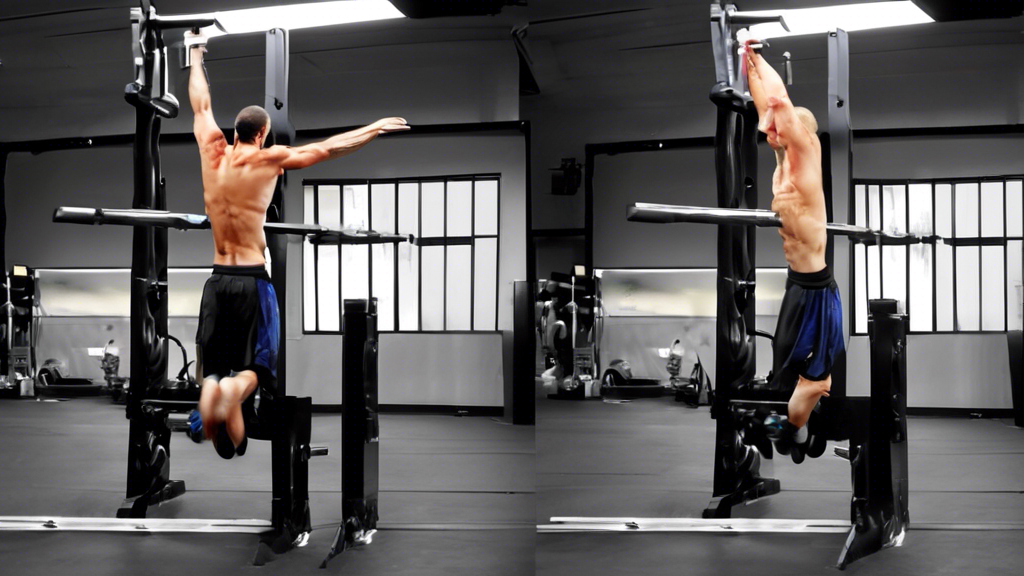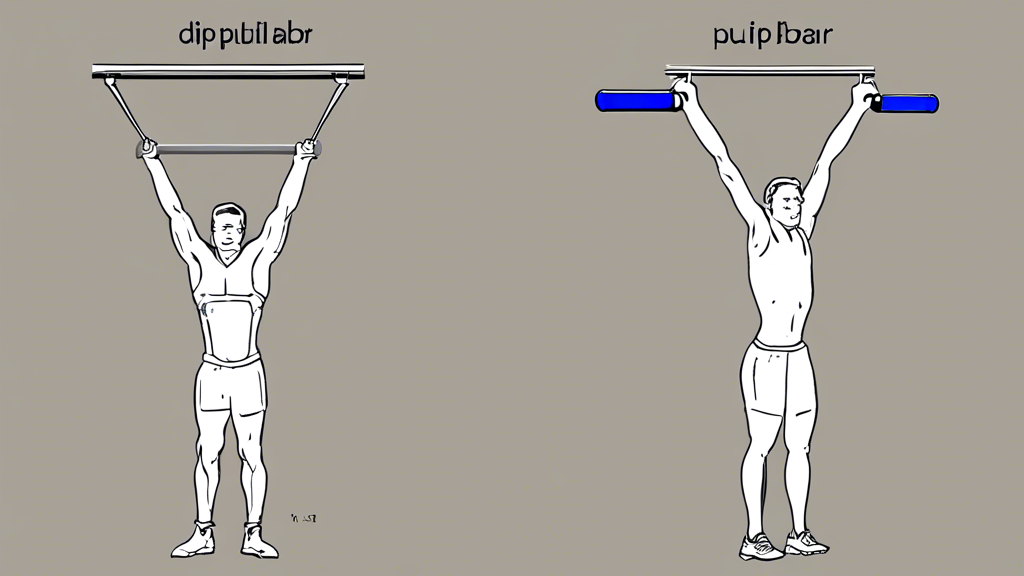In the ever-evolving world of fitness, pull-up bars and dip bars have become essential components of any comprehensive home fitness setup. As more individuals prioritize home workouts, understanding the distinct characteristics and benefits of these two pieces of equipment becomes crucial for maximizing the efficiency of their exercise routines. Pull-up bars and dip bars, while both invaluable, serve different purposes and offer unique advantages by targeting different muscle groups and allowing for varied workout techniques. Grasping the nuances between them can help fitness enthusiasts optimize their training and achieve specific fitness goals more effectively. In this article, we will delve into the fundamental differences between pull-up bars and dip bars, examining their structural distinctions and the specific exercises they facilitate, to help you make informed decisions for your home fitness bar setup.
When setting up a home fitness bar, understanding the various types of equipment available is crucial for effective workouts. Among the most popular and versatile options are pull-up bars and dip bars. Both of these fitness tools can dramatically improve your strength, endurance, and overall physical fitness, but they serve different purposes and work on different muscle groups. A well-rounded fitness routine often incorporates both types of bars, but understanding their differences can help you make a more informed decision about which is best for your home gym.
First, let’s take a closer look at what pull-up bars and dip bars actually are, and what role they play in fitness routines.
Pull-up bars are typically horizontal bars that can be fixed to doorways, walls, or ceilings. They are designed to allow you to perform pull-ups, which involve lifting your body up and down using your arms. Pull-ups are a powerful exercise primarily targeting your upper body muscles, including the latissimus dorsi (lats), biceps, and shoulders. They can also engage your core, biceps, and forearms. Push or pull variations, such as chin-ups or wide grip pull-ups, allow for targeted workouts that focus on different parts of your upper body, making it a versatile addition to your home gym setup.
Dip bars, on the other hand, consist of two parallel bars that are typically used for performing dips, a compound push exercise where you support your body above the bars, lower yourself by bending your elbows, and then push yourself back up to the starting position. Dips are highly effective for building your triceps, chest, and shoulders. Variations like tricep dips and chest dips can shift the focus to different parts of your upper body. Some dip bars are integrated into power towers that combine multiple workout stations into one piece of equipment, while others are portable and can be set up in various places around your home gym.
Understanding the differences between these two types of bars is essential for constructing a balanced workout routine. Each piece of equipment offers unique benefits and targets different muscle groups, contributing to a well-rounded fitness regimen. However, comfort, space, and fitness goals are all important factors to consider when choosing between them.
Importance of Understanding the Differences for Effective Workouts
Having a clear comprehension of the functional distinctions between pull-up bars and dip bars is vital for anyone committing to a structured fitness routine. Each tool has specific benefits that can fit into various aspects of your workout goals. Whether you’re focusing on building muscle, improving endurance, or enhancing core strength, knowing which bar to use for your target exercises will enable you to design a more efficient and effective workout plan.
One of the primary benefits of pull-up bars is their ability to engage a wide range of upper body muscles in one fluid motion. The mechanics of pull-ups require you to stabilize your entire body, engaging not only your arms and back but also your core. This makes pull-up bars an excellent choice for those aiming to develop upper body strength and improve functional fitness. Additionally, since pull-up bars can be easily installed in various locations within your home, they offer a convenient and accessible way to incorporate strength training into your daily routine.
Dip bars, meanwhile, offer a unique set of advantages for developing upper body muscle strength. Dips are exceptional for isolating and working the chest, triceps, and shoulders. Because dips mimic pushing motions, they are particularly beneficial for individuals looking to enhance pushing strength, which is crucial for various athletic and everyday activities. The fact that dip bars often come as part of multi-functional fitness stations means they can be a versatile addition to your home gym setup, offering the ability to perform a variety of exercises in one location.
Understanding the differences between pull-up bars and dip bars can also help in preventing workout monotony. Each tool encourages different movements and muscle engagements, which can keep your fitness routine fresh and challenging. This can be particularly important for long-term adherence to a workout program, as variety often boosts motivation and enjoyment.
Moreover, the right choice of equipment can minimize the risk of injury. Knowing which bar to use for specific muscle groups and exercises ensures that your movements are biomechanically sound, thereby reducing the strain on joints and ligaments. For example, someone with shoulder issues might find dips more challenging and potentially harmful than pull-ups, and thus opt for a more suitable workout.
In essence, whether you opt for a pull-up bar or a dip bar—or integrate both into your home gym—understanding their specific uses and benefits will allow you to maximize your workouts and tailor them to fit your personal fitness goals. By doing so, you not only enhance your physical capabilities but also create a balanced and enjoyable fitness regimen.

Key Differences Between Pull-Up Bars and Dip Bars
Understanding the key differences between pull-up bars and dip bars is crucial for anyone looking to optimize their home fitness routine. Both types of bars offer unique benefits and target specific muscle groups differently. Let’s break down these differences in detail to help you make the most informed choice for your home workouts.
Structural Differences: Design and Installation
The structural differences between pull-up bars and dip bars are significant and influence their functionality and installation methods. Pull-up bars are generally designed to be mounted higher, often on door frames, walls, or even ceilings. They are built to support your full body weight as you perform exercises such as pull-ups, chin-ups, and hanging leg raises. The key feature of a pull-up bar is its high placement, allowing for a full range of vertical movement.
In contrast, dip bars are usually installed at waist or chest level and come in various forms, such as standalone dip stations, parallel bars, or even wall-mounted versions. The primary design feature of dip bars is their horizontal parallel bars, which are used for exercises like dips, knee raises, and L-sits. Due to their lower positioning, dip bars can be more versatile in a compact home gym setup.
When considering installation, pull-up bars may require more permanent fixtures or robust door frame attachments to ensure they can bear the exerted weight without compromising stability. On the other hand, dip bars often come with freestanding options, which can be easily moved and stored when not in use, making them a convenient choice for those with limited space.
Exercise Focus: Muscles Targeted and Workout Variations
The exercises performed on pull-up bars and dip bars target different muscle groups, making them suitable for distinct fitness goals. Pull-up bars primarily engage the upper body, particularly focusing on the back, shoulders, and arms. Exercises like pull-ups and chin-ups are excellent for building latissimus dorsi (lats), biceps, and forearm strength. Additionally, hanging leg raises performed on a pull-up bar can effectively target the core muscles.
Dip bars, on the other hand, are designed to emphasize the chest, triceps, and shoulders. The classic dip exercise is one of the best movements for building chest and tricep strength, offering a compound workout that can also involve the core when stability is maintained. Other exercises like knee raises and L-sits on dip bars further enhance abdominal and hip flexor strength.
Workout variations offered by each type of bar also play a crucial role in their effectiveness. Pull-up bars allow for a range of grip positions – wide, narrow, overhand, and underhand – each targeting different muscle groups and providing varied workout intensities. This versatility makes pull-up bars a highly effective tool for upper body development and functional strength training.
Dip bars offer different variations primarily by adjusting the body angle and leg positions. For instance, leaning slightly forward engages the chest more, whereas keeping the body upright focuses the effort on the triceps. Additionally, performing exercises like the Russian dip or straight bar dips can introduce new challenges and stimulate muscle growth in different ways.
Ultimately, the choice between a pull-up bar and a dip bar depends on your fitness objectives and the muscle groups you aim to develop. For comprehensive upper body strength and conditioning, incorporating both types of bars into your home fitness setup can provide a balanced and effective workout regimen.
In summary, while pull-up bars and dip bars share the common goal of enhancing upper body strength, their structural differences and the specific exercises they support make them uniquely advantageous based on your fitness needs. By understanding these key differences, you can better tailor your home workouts to meet your individual goals and optimize your fitness results.
In conclusion, pull-up bars and dip bars, though both valuable additions to a home fitness setup, serve distinct purposes and target different muscle groups, contributing uniquely to a well-rounded fitness regimen. Pull-up bars, with their horizontal design and overhead installation, primarily engage the upper body, focusing on muscles such as the latissimus dorsi, biceps, and shoulders. They are ideal for exercises like pull-ups, chin-ups, and hanging leg raises, offering versatility for those looking to enhance their upper body strength and grip.
On the other hand, dip bars, typically consisting of parallel bars positioned at waist height, concentrate on the triceps, chest, and shoulders. They provide a stable platform for dips, L-sits, and leg raises, making them excellent for developing the pushing muscles and core stability. The vertical push motion required in dips complements the pulling motion involved in pull-ups, ensuring a balanced and comprehensive upper body workout.
Understanding these distinctions is essential for anyone curating a home fitness environment to ensure they maximize their workout efficiency and achieve their fitness goals. Whether your focus is on building a powerful back with a pull-up bar or sculpting defined triceps and chest muscles with a dip bar, incorporating both into your routine can provide a diverse and effective approach to strength training. As each bar supports different exercises and muscle engagements, integrating them both can lead to more holistic and balanced physical development.

